University Nursing Assignment: Effective Communication in Healthcare
VerifiedAdded on 2021/04/24
|7
|1227
|469
Homework Assignment
AI Summary
This nursing assignment examines effective communication techniques in healthcare settings. It begins with an overview of primary health assessments and normal health parameters (blood pressure, temperature, respirations, and pulse rate) for adults aged 30-40. The assignment then contrasts these parameters with those of elderly patients (aged 72) and children (aged 6-10), highlighting age-related differences. The core of the assignment focuses on identifying and analyzing effective communication techniques used in a provided video, referencing the prescribed text and additional literature to explain their effectiveness in maintaining patient engagement and promoting good clinical practice. The student emphasizes the importance of clear, polite, and attentive communication, as well as the need to consider environmental factors and patient privacy, and detailed documentation for effective patient care. References are provided to support the analysis.
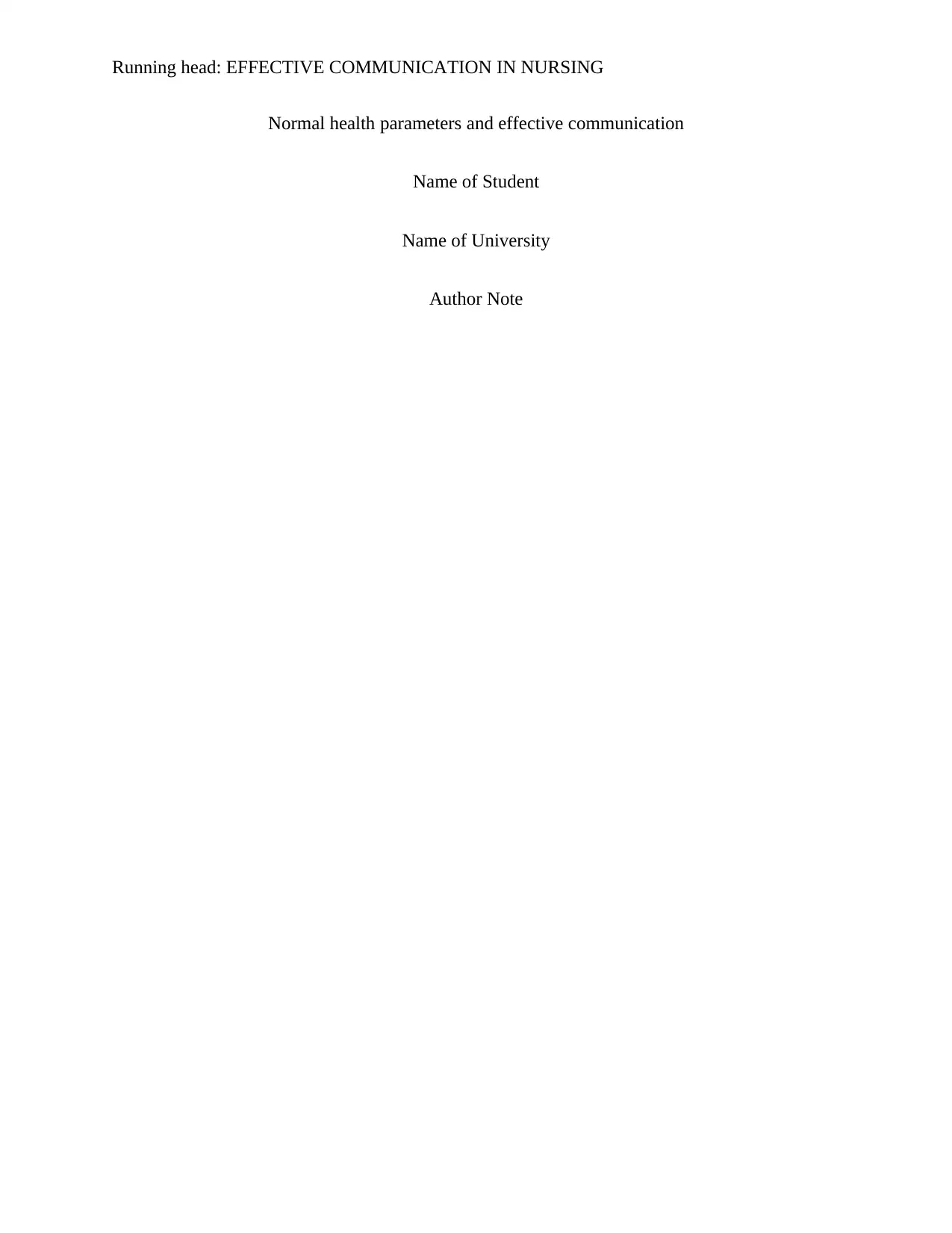
Running head: EFFECTIVE COMMUNICATION IN NURSING
Normal health parameters and effective communication
Name of Student
Name of University
Author Note
Normal health parameters and effective communication
Name of Student
Name of University
Author Note
Paraphrase This Document
Need a fresh take? Get an instant paraphrase of this document with our AI Paraphraser
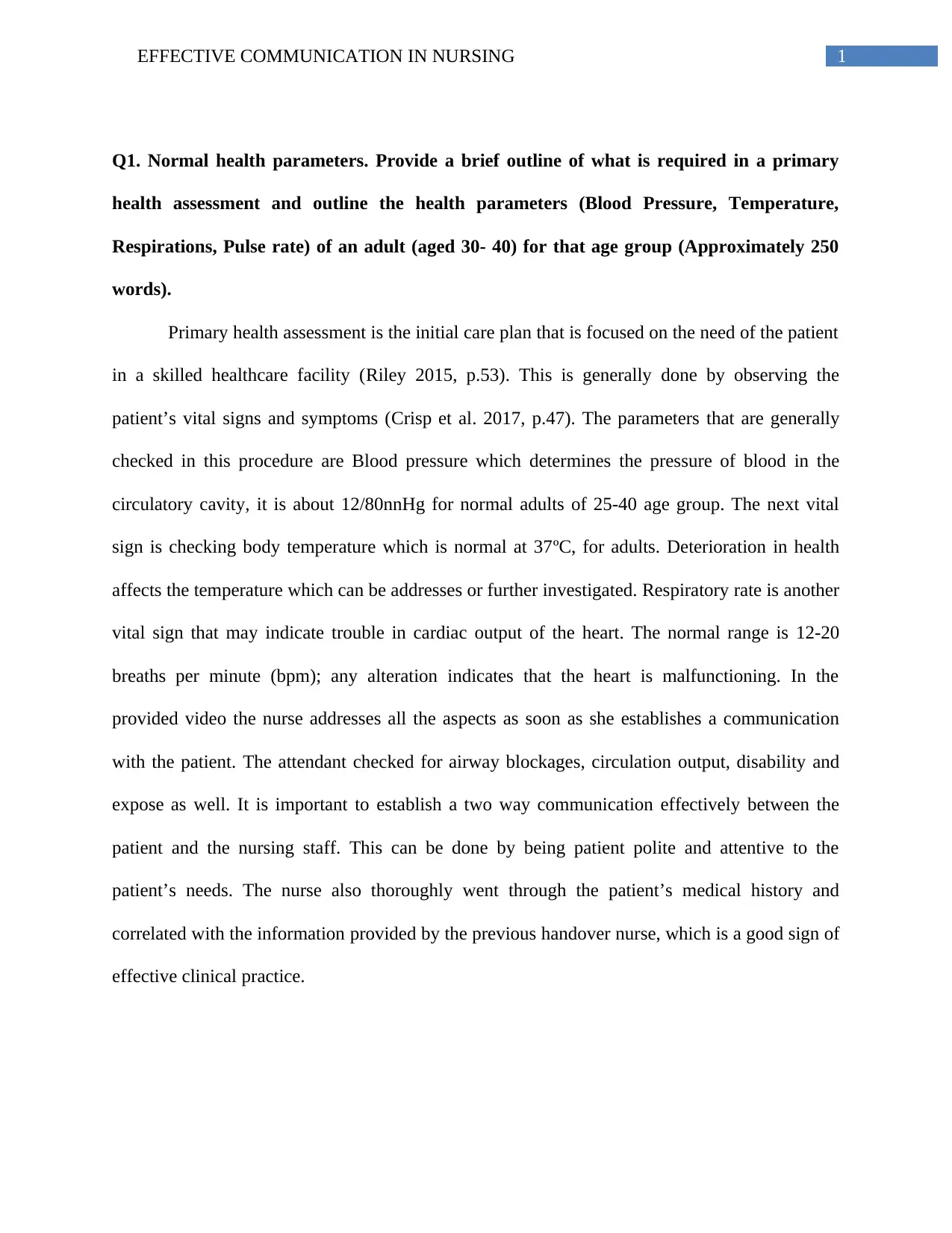
1EFFECTIVE COMMUNICATION IN NURSING
Q1. Normal health parameters. Provide a brief outline of what is required in a primary
health assessment and outline the health parameters (Blood Pressure, Temperature,
Respirations, Pulse rate) of an adult (aged 30- 40) for that age group (Approximately 250
words).
Primary health assessment is the initial care plan that is focused on the need of the patient
in a skilled healthcare facility (Riley 2015, p.53). This is generally done by observing the
patient’s vital signs and symptoms (Crisp et al. 2017, p.47). The parameters that are generally
checked in this procedure are Blood pressure which determines the pressure of blood in the
circulatory cavity, it is about 12/80nnHg for normal adults of 25-40 age group. The next vital
sign is checking body temperature which is normal at 37ºC, for adults. Deterioration in health
affects the temperature which can be addresses or further investigated. Respiratory rate is another
vital sign that may indicate trouble in cardiac output of the heart. The normal range is 12-20
breaths per minute (bpm); any alteration indicates that the heart is malfunctioning. In the
provided video the nurse addresses all the aspects as soon as she establishes a communication
with the patient. The attendant checked for airway blockages, circulation output, disability and
expose as well. It is important to establish a two way communication effectively between the
patient and the nursing staff. This can be done by being patient polite and attentive to the
patient’s needs. The nurse also thoroughly went through the patient’s medical history and
correlated with the information provided by the previous handover nurse, which is a good sign of
effective clinical practice.
Q1. Normal health parameters. Provide a brief outline of what is required in a primary
health assessment and outline the health parameters (Blood Pressure, Temperature,
Respirations, Pulse rate) of an adult (aged 30- 40) for that age group (Approximately 250
words).
Primary health assessment is the initial care plan that is focused on the need of the patient
in a skilled healthcare facility (Riley 2015, p.53). This is generally done by observing the
patient’s vital signs and symptoms (Crisp et al. 2017, p.47). The parameters that are generally
checked in this procedure are Blood pressure which determines the pressure of blood in the
circulatory cavity, it is about 12/80nnHg for normal adults of 25-40 age group. The next vital
sign is checking body temperature which is normal at 37ºC, for adults. Deterioration in health
affects the temperature which can be addresses or further investigated. Respiratory rate is another
vital sign that may indicate trouble in cardiac output of the heart. The normal range is 12-20
breaths per minute (bpm); any alteration indicates that the heart is malfunctioning. In the
provided video the nurse addresses all the aspects as soon as she establishes a communication
with the patient. The attendant checked for airway blockages, circulation output, disability and
expose as well. It is important to establish a two way communication effectively between the
patient and the nursing staff. This can be done by being patient polite and attentive to the
patient’s needs. The nurse also thoroughly went through the patient’s medical history and
correlated with the information provided by the previous handover nurse, which is a good sign of
effective clinical practice.
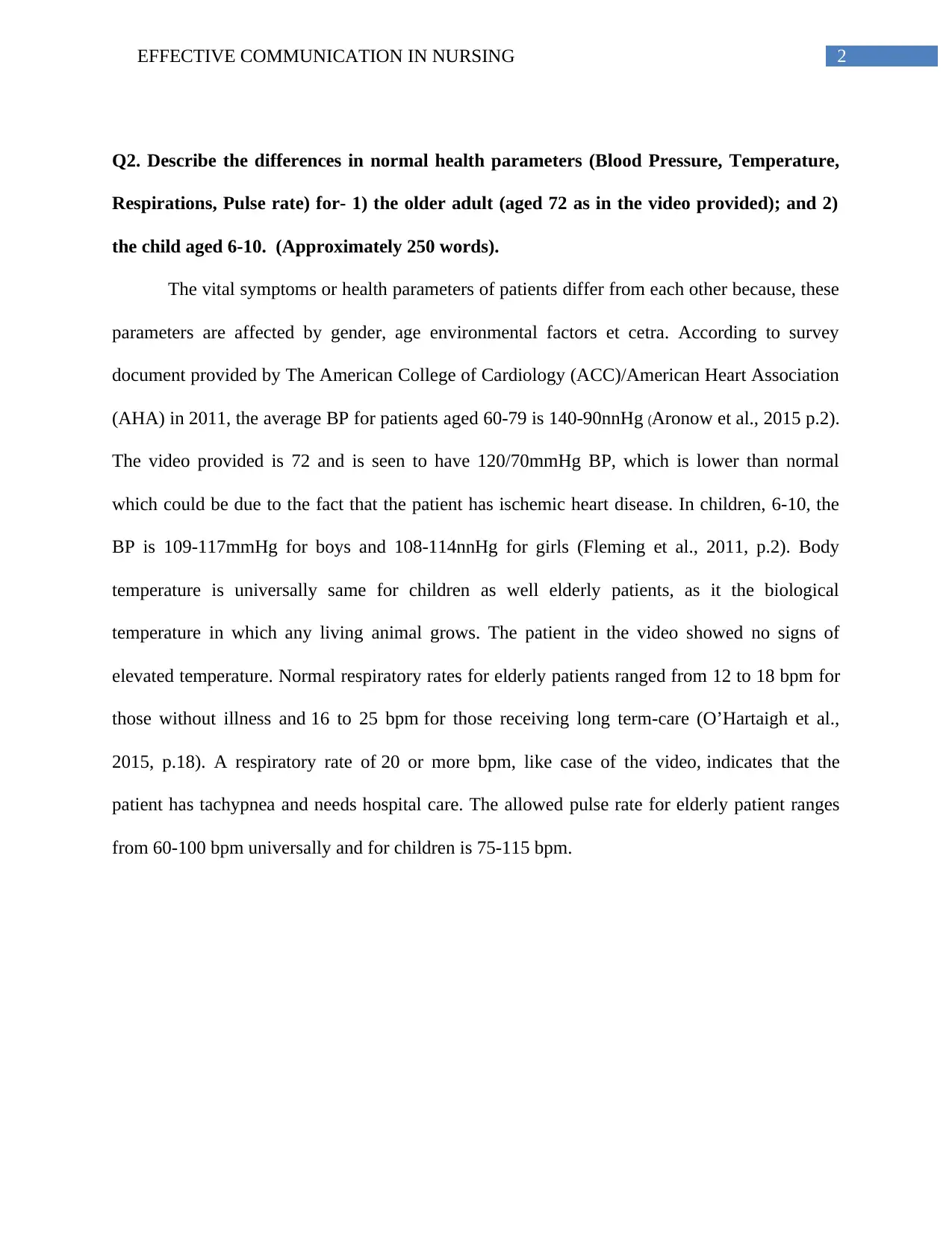
2EFFECTIVE COMMUNICATION IN NURSING
Q2. Describe the differences in normal health parameters (Blood Pressure, Temperature,
Respirations, Pulse rate) for- 1) the older adult (aged 72 as in the video provided); and 2)
the child aged 6-10. (Approximately 250 words).
The vital symptoms or health parameters of patients differ from each other because, these
parameters are affected by gender, age environmental factors et cetra. According to survey
document provided by The American College of Cardiology (ACC)/American Heart Association
(AHA) in 2011, the average BP for patients aged 60-79 is 140-90nnHg (Aronow et al., 2015 p.2).
The video provided is 72 and is seen to have 120/70mmHg BP, which is lower than normal
which could be due to the fact that the patient has ischemic heart disease. In children, 6-10, the
BP is 109-117mmHg for boys and 108-114nnHg for girls (Fleming et al., 2011, p.2). Body
temperature is universally same for children as well elderly patients, as it the biological
temperature in which any living animal grows. The patient in the video showed no signs of
elevated temperature. Normal respiratory rates for elderly patients ranged from 12 to 18 bpm for
those without illness and 16 to 25 bpm for those receiving long term-care (O’Hartaigh et al.,
2015, p.18). A respiratory rate of 20 or more bpm, like case of the video, indicates that the
patient has tachypnea and needs hospital care. The allowed pulse rate for elderly patient ranges
from 60-100 bpm universally and for children is 75-115 bpm.
Q2. Describe the differences in normal health parameters (Blood Pressure, Temperature,
Respirations, Pulse rate) for- 1) the older adult (aged 72 as in the video provided); and 2)
the child aged 6-10. (Approximately 250 words).
The vital symptoms or health parameters of patients differ from each other because, these
parameters are affected by gender, age environmental factors et cetra. According to survey
document provided by The American College of Cardiology (ACC)/American Heart Association
(AHA) in 2011, the average BP for patients aged 60-79 is 140-90nnHg (Aronow et al., 2015 p.2).
The video provided is 72 and is seen to have 120/70mmHg BP, which is lower than normal
which could be due to the fact that the patient has ischemic heart disease. In children, 6-10, the
BP is 109-117mmHg for boys and 108-114nnHg for girls (Fleming et al., 2011, p.2). Body
temperature is universally same for children as well elderly patients, as it the biological
temperature in which any living animal grows. The patient in the video showed no signs of
elevated temperature. Normal respiratory rates for elderly patients ranged from 12 to 18 bpm for
those without illness and 16 to 25 bpm for those receiving long term-care (O’Hartaigh et al.,
2015, p.18). A respiratory rate of 20 or more bpm, like case of the video, indicates that the
patient has tachypnea and needs hospital care. The allowed pulse rate for elderly patient ranges
from 60-100 bpm universally and for children is 75-115 bpm.
⊘ This is a preview!⊘
Do you want full access?
Subscribe today to unlock all pages.

Trusted by 1+ million students worldwide

3EFFECTIVE COMMUNICATION IN NURSING
Q3. Using the Effective Communication Techniques on p.19 - 26 in the prescribed text
(Estes et al., 2016), identify which effective communication techniques were utilised in the
video, and using additional literature to support your points explain how these techniques
were effective. (Approximately250 words).
Effective communication is very important to maintain patient engagement and perform
with good clinical practice (Riley 2015, p.231). It is the nurse’s duty to engage the patient in
effective communication and make them feel comfortable, a good way to do this by practising an
interview based communication. Certain factors influence patient interview, like, approach by
which a nurse is reaching out to the patient. This communication needs to polite, clear and
simple, which the nurse seems to be following in the video. Another factor is environment,
which makes the patient feel comfortable to share his/her experience, problem et cetra, the
patient appears to be comfortable in the hospital setting and the nurse has good listening skills
which reassures the patient (Estes et al., 2016, p.22). Care has to be taken when dealing with
children and elderly as they require more attention. Keeping the confidence of a patient is very
important to establish trust and engage the patient in clinical trials. Many laws and guidelines
have been regulated to control privacy of an individual in a healthcare setting. It is important to
takes notes during a clinical assessment to reflect later and provide useful information to the nest
handover nurse, which the nurse seems to be writing down the vital sign reports after her check-
up (Estes et al., 2016, p.22). The nurse seems to be patient and takes ample time to complete her
check-up, which is very important in health care settings as, rushed or hurried decision can cause
clinical errors. The nurse should have no bias or preconceived notions regarding the patient, or
their condition.
Q3. Using the Effective Communication Techniques on p.19 - 26 in the prescribed text
(Estes et al., 2016), identify which effective communication techniques were utilised in the
video, and using additional literature to support your points explain how these techniques
were effective. (Approximately250 words).
Effective communication is very important to maintain patient engagement and perform
with good clinical practice (Riley 2015, p.231). It is the nurse’s duty to engage the patient in
effective communication and make them feel comfortable, a good way to do this by practising an
interview based communication. Certain factors influence patient interview, like, approach by
which a nurse is reaching out to the patient. This communication needs to polite, clear and
simple, which the nurse seems to be following in the video. Another factor is environment,
which makes the patient feel comfortable to share his/her experience, problem et cetra, the
patient appears to be comfortable in the hospital setting and the nurse has good listening skills
which reassures the patient (Estes et al., 2016, p.22). Care has to be taken when dealing with
children and elderly as they require more attention. Keeping the confidence of a patient is very
important to establish trust and engage the patient in clinical trials. Many laws and guidelines
have been regulated to control privacy of an individual in a healthcare setting. It is important to
takes notes during a clinical assessment to reflect later and provide useful information to the nest
handover nurse, which the nurse seems to be writing down the vital sign reports after her check-
up (Estes et al., 2016, p.22). The nurse seems to be patient and takes ample time to complete her
check-up, which is very important in health care settings as, rushed or hurried decision can cause
clinical errors. The nurse should have no bias or preconceived notions regarding the patient, or
their condition.
Paraphrase This Document
Need a fresh take? Get an instant paraphrase of this document with our AI Paraphraser
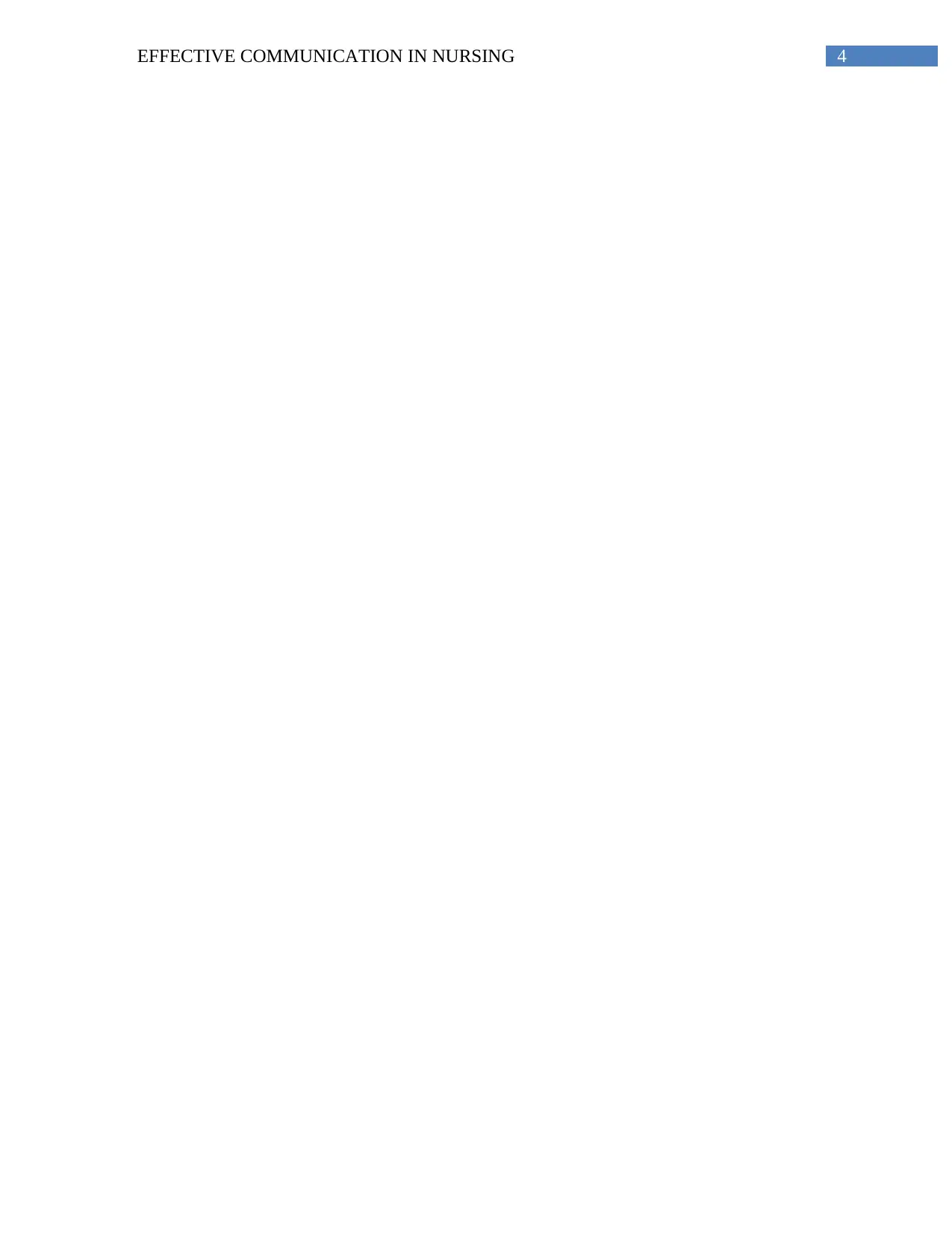
4EFFECTIVE COMMUNICATION IN NURSING
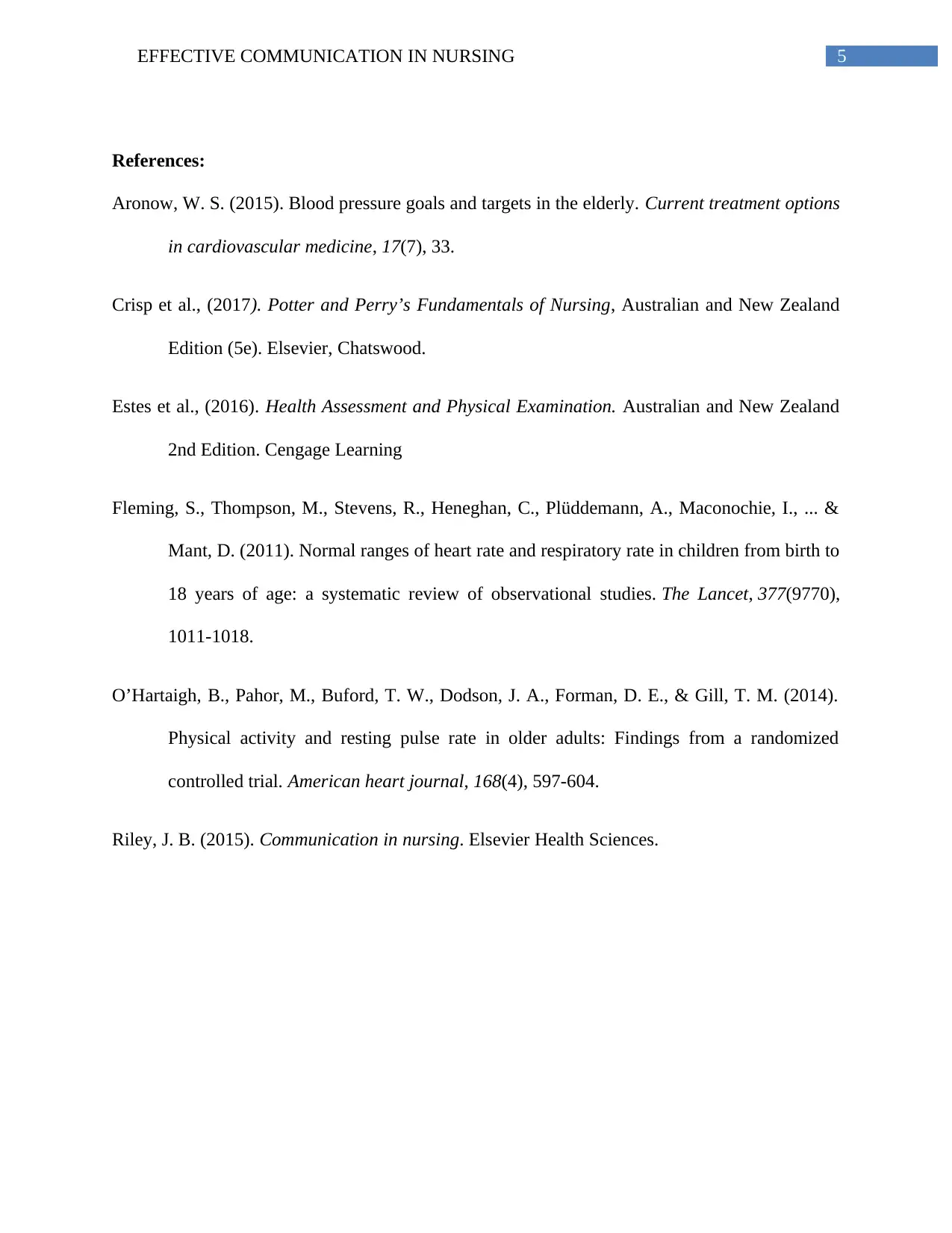
5EFFECTIVE COMMUNICATION IN NURSING
References:
Aronow, W. S. (2015). Blood pressure goals and targets in the elderly. Current treatment options
in cardiovascular medicine, 17(7), 33.
Crisp et al., (2017). Potter and Perry’s Fundamentals of Nursing, Australian and New Zealand
Edition (5e). Elsevier, Chatswood.
Estes et al., (2016). Health Assessment and Physical Examination. Australian and New Zealand
2nd Edition. Cengage Learning
Fleming, S., Thompson, M., Stevens, R., Heneghan, C., Plüddemann, A., Maconochie, I., ... &
Mant, D. (2011). Normal ranges of heart rate and respiratory rate in children from birth to
18 years of age: a systematic review of observational studies. The Lancet, 377(9770),
1011-1018.
O’Hartaigh, B., Pahor, M., Buford, T. W., Dodson, J. A., Forman, D. E., & Gill, T. M. (2014).
Physical activity and resting pulse rate in older adults: Findings from a randomized
controlled trial. American heart journal, 168(4), 597-604.
Riley, J. B. (2015). Communication in nursing. Elsevier Health Sciences.
References:
Aronow, W. S. (2015). Blood pressure goals and targets in the elderly. Current treatment options
in cardiovascular medicine, 17(7), 33.
Crisp et al., (2017). Potter and Perry’s Fundamentals of Nursing, Australian and New Zealand
Edition (5e). Elsevier, Chatswood.
Estes et al., (2016). Health Assessment and Physical Examination. Australian and New Zealand
2nd Edition. Cengage Learning
Fleming, S., Thompson, M., Stevens, R., Heneghan, C., Plüddemann, A., Maconochie, I., ... &
Mant, D. (2011). Normal ranges of heart rate and respiratory rate in children from birth to
18 years of age: a systematic review of observational studies. The Lancet, 377(9770),
1011-1018.
O’Hartaigh, B., Pahor, M., Buford, T. W., Dodson, J. A., Forman, D. E., & Gill, T. M. (2014).
Physical activity and resting pulse rate in older adults: Findings from a randomized
controlled trial. American heart journal, 168(4), 597-604.
Riley, J. B. (2015). Communication in nursing. Elsevier Health Sciences.
⊘ This is a preview!⊘
Do you want full access?
Subscribe today to unlock all pages.

Trusted by 1+ million students worldwide

6EFFECTIVE COMMUNICATION IN NURSING
1 out of 7
Related Documents
Your All-in-One AI-Powered Toolkit for Academic Success.
+13062052269
info@desklib.com
Available 24*7 on WhatsApp / Email
![[object Object]](/_next/static/media/star-bottom.7253800d.svg)
Unlock your academic potential
Copyright © 2020–2025 A2Z Services. All Rights Reserved. Developed and managed by ZUCOL.





